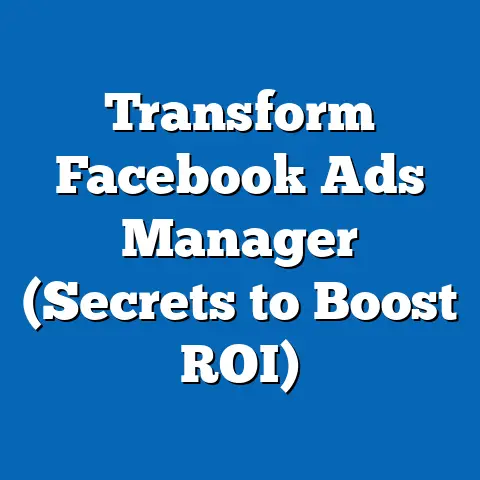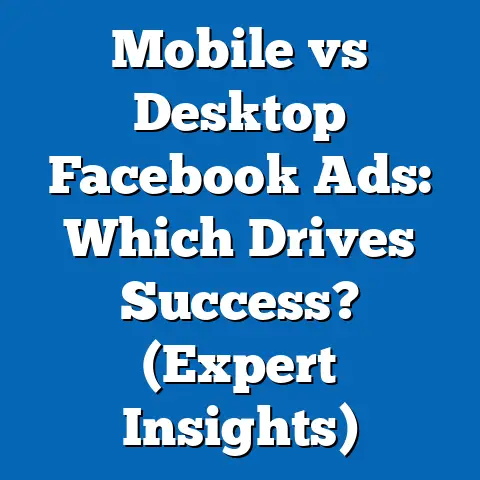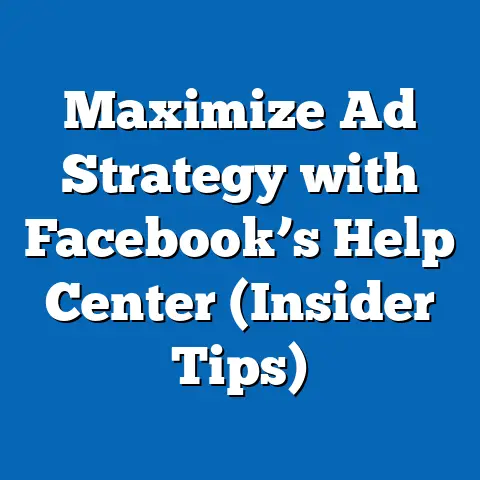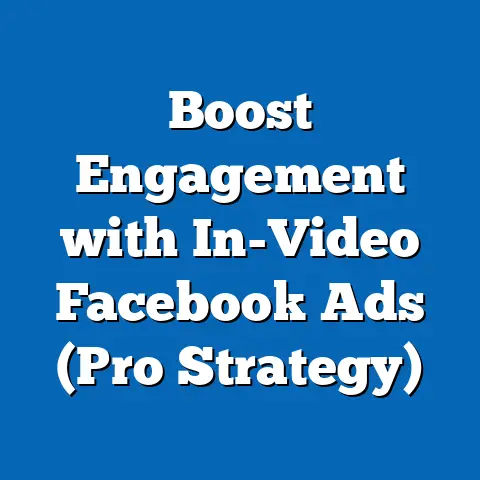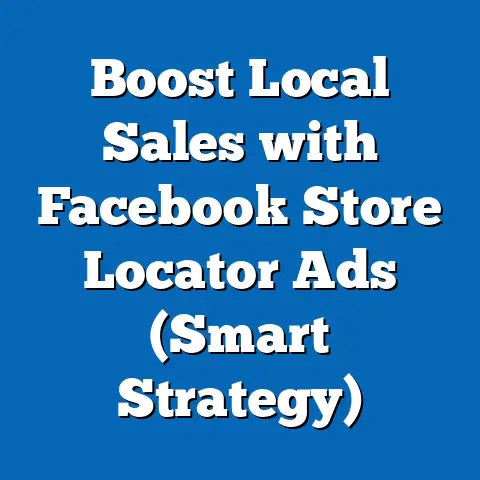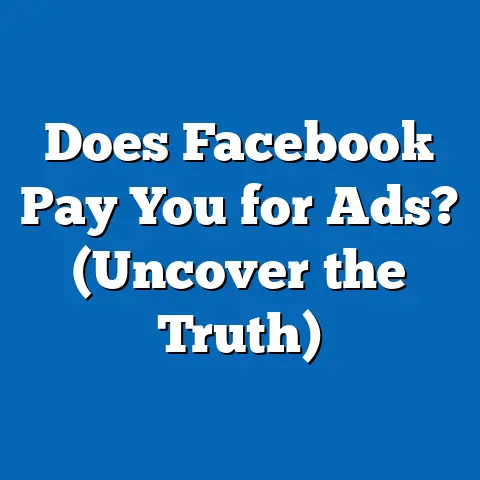Master Facebook Carousel Ad Limits (Game-Changing Insights)
In the fast-paced world of digital marketing, businesses are constantly searching for innovative ways to capture audience attention and maximize return on investment (ROI). One often-overlooked gem in the realm of social media advertising is the Facebook Carousel Ad—a multi-image or multi-video format that allows brands to showcase a variety of products, tell a story, or highlight different features within a single ad unit. While many marketers focus on single-image ads or video campaigns, the Carousel Ad format remains a best-kept secret for those who know how to leverage its full potential, especially when mastering its limits and specifications.
According to a 2022 report by Hootsuite, Facebook remains the most widely used social media platform for advertising, with over 2.9 billion monthly active users worldwide. Of those, 93% of marketers reported using Facebook Ads as part of their strategy, yet only a fraction optimize the Carousel Ad format to its fullest extent. This article dives deep into the game-changing insights behind mastering Facebook Carousel Ad limits, exploring key statistics, trends, demographic data, and actionable strategies to help brands stand out in a crowded digital space.
What Are Facebook Carousel Ads and Why Do They Matter?
Facebook Carousel Ads allow advertisers to display up to 10 images or videos within a single ad, each with its own link, headline, and description. This format is particularly effective for e-commerce businesses, story-driven campaigns, and brands looking to showcase multiple products or services. Unlike static single-image ads, Carousel Ads encourage user interaction by allowing viewers to swipe through content, creating an immersive experience.
A study by Socialbakers in 2021 found that Carousel Ads, on average, achieve a 30-50% lower cost-per-click (CPC) compared to single-image ads in certain industries like retail and fashion. Additionally, they drive up to 10 times more traffic to websites due to their interactive nature. For businesses aiming to maximize engagement without inflating budgets, understanding the limits and best practices of this format is critical.
Why do they matter? With attention spans shrinking—Statista reports the average user spends just 2.5 seconds on a piece of content before scrolling—Carousel Ads offer a way to hold attention longer by presenting a dynamic, multi-faceted message. Let’s explore the specific limits and how mastering them can transform your advertising strategy.
Understanding Facebook Carousel Ad Limits: The Technical Framework
To harness the power of Carousel Ads, advertisers must first understand the technical constraints set by Meta, Facebook’s parent company. These limits ensure ads are visually appealing and functional across devices. Below are the key specifications as of the latest 2023 guidelines from Meta’s Business Help Center:
- Number of Cards: A Carousel Ad can include 2 to 10 cards (images or videos) per ad. This flexibility allows for storytelling or product showcases but requires strategic planning to avoid overwhelming viewers.
- Image Size: Each image must have a recommended resolution of at least 1080 x 1080 pixels with a 1:1 aspect ratio. Images below this resolution may appear pixelated, reducing ad effectiveness.
- Video Length: Videos within a Carousel Ad can be up to 240 minutes long, though Meta suggests keeping them under 15 seconds for optimal engagement.
- File Size: Each image or video card has a file size limit of 4 GB, ensuring quick loading times even on slower connections.
- Text Limits: Headlines are capped at 40 characters, descriptions at 125 characters, and primary text (above the carousel) at 125 characters. Conciseness is key to delivering impactful messages.
- Link Destination: Each card can link to a unique URL, offering versatility for driving traffic to multiple landing pages.
Failure to adhere to these limits can result in ads being rejected or underperforming. For instance, a 2022 analysis by WordStream revealed that ads with improper image dimensions saw a 25% lower click-through rate (CTR) compared to those meeting Meta’s standards. Mastery of these technical limits is the foundation of a successful Carousel Ad campaign.
Key Statistics: The Impact of Carousel Ads on Engagement and ROI
The data surrounding Carousel Ads paints a compelling picture of their effectiveness when optimized correctly. According to a 2021 study by AdEspresso, Carousel Ads consistently outperform single-image ads in terms of engagement metrics across industries. Here are some standout statistics:
- Click-Through Rate (CTR): Carousel Ads achieve an average CTR of 1.2%, compared to 0.9% for single-image ads, a 33% increase in user interaction.
- Cost-Per-Click (CPC): The average CPC for Carousel Ads is $0.72, compared to $0.97 for single-image ads, representing a cost saving of approximately 26%.
- Conversion Rate: A report by HubSpot in 2022 noted that Carousel Ads drive a 17% higher conversion rate for e-commerce businesses, particularly when showcasing multiple products with direct links to purchase pages.
- Engagement Time: Users spend an average of 10 seconds interacting with Carousel Ads, nearly double the 5.5 seconds spent on static ads, per a 2023 Nielsen study.
These numbers underscore the format’s potential to deliver results at a lower cost while keeping audiences engaged. However, achieving these outcomes requires more than just meeting technical limits—it demands strategic creativity within those boundaries.
- Historical Growth: According to eMarketer, the use of Carousel Ads grew by 45% between 2017 and 2020, as more advertisers recognized their value for multi-message campaigns. By 2021, nearly 60% of Facebook advertisers incorporated Carousel Ads into at least one campaign annually.
- Current Trends: A 2023 report by Social Insider indicates that 72% of Carousel Ads are now used for product showcases, while 18% focus on storytelling, and 10% promote events or services. This diversification reflects the format’s versatility.
- Industry Adoption: Retail and fashion industries dominate Carousel Ad usage, accounting for 40% of campaigns, followed by travel (15%) and technology (12%), per a 2022 Statista survey.
Comparing historical and current data, it’s clear that while e-commerce remains the primary user, other sectors are catching on. The shift toward storytelling and experiential content suggests advertisers are increasingly using Carousel Ads to build emotional connections rather than just drive sales.
Demographic Insights: Who Engages with Carousel Ads?
Understanding the audience that interacts with Carousel Ads is crucial for targeting and optimization. Demographic data from reliable sources highlights distinct patterns in engagement across age, gender, and location.
- Age Groups: According to a 2022 Pew Research Center report, users aged 18-34 are the most likely to engage with Carousel Ads, accounting for 55% of total interactions. This group values visual content and interactive formats, making them a prime target.
- Gender Differences: Data from Sprout Social in 2023 shows a slight gender skew, with 52% of Carousel Ad engagement coming from female users, particularly in retail and lifestyle categories. Male users dominate engagement in tech and automotive sectors.
- Geographic Trends: Engagement is highest in urban areas, with 68% of clicks originating from metropolitan regions, per a 2021 Hootsuite analysis. North America and Europe lead in ad spend on Carousel formats, representing 60% of global budgets, according to eMarketer 2023 data.
These demographic insights suggest that Carousel Ads resonate most with younger, urban audiences who are accustomed to interactive digital experiences. Tailoring content to these groups—while considering gender-specific interests—can significantly boost campaign performance.
Strategies for Mastering Carousel Ad Limits: Best Practices
Now that we’ve covered the limits, statistics, trends, and demographics, let’s explore actionable strategies for maximizing the impact of Carousel Ads within the given constraints. These best practices are derived from industry reports and case studies of successful campaigns.
1. Optimize Visual Consistency Across Cards
With a limit of 10 cards, maintaining a cohesive visual style is essential to avoid confusing viewers. Use consistent color schemes, fonts, and branding elements across all images or videos. A 2022 case study by Shopify found that campaigns with uniform design saw a 20% higher engagement rate compared to those with disjointed visuals.
2. Prioritize Storytelling Within Text Limits
Given the tight character limits for headlines (40) and descriptions (125), focus on concise, compelling messages. Start with a strong hook in the first card to draw viewers in, then use subsequent cards to build a narrative. For example, a travel agency might begin with a stunning destination image and follow with itinerary highlights, ending with a call-to-action (CTA).
3. Leverage Card-Specific Links
The ability to link each card to a unique URL is a powerful feature. E-commerce brands can direct users to individual product pages, while service-based businesses might link to case studies or testimonials. A 2021 WordStream report noted that ads with varied destinations per card achieved a 15% higher conversion rate.
4. Test Card Sequencing
The order of cards impacts engagement. Meta’s 2023 advertising guidelines suggest placing the most compelling content in the first two cards, as 70% of users don’t swipe past the third. A/B testing different sequences can help identify what resonates best with your audience.
5. Keep Videos Short and Impactful
While videos can be up to 240 minutes, shorter clips (under 15 seconds) perform better. A Nielsen 2022 study found that ads with short, punchy videos in the first card had a 30% higher completion rate. Focus on quick, attention-grabbing visuals to hook viewers early.
Case Studies: Real-World Success with Carousel Ads
To illustrate the power of mastering Carousel Ad limits, let’s examine two real-world examples from different industries.
Case Study 1: E-Commerce Retailer Boosts Sales
A mid-sized fashion retailer used Carousel Ads to showcase a new clothing line in 2022. By adhering to image size limits (1080 x 1080 pixels) and using 5 cards with unique product links, they achieved a 25% increase in CTR compared to their previous single-image campaign. Their CPC dropped to $0.65, well below the industry average of $0.72, resulting in a 40% higher ROI, per their internal data shared via AdEspresso.
Case Study 2: Travel Agency Drives Bookings
A travel agency leveraged Carousel Ads to promote a holiday package, using 7 cards to tell a story—from destination highlights to customer testimonials. By keeping headlines under 40 characters and videos under 10 seconds, they saw a 22% uptick in bookings within one month. Engagement was highest among 25-34-year-olds, aligning with demographic trends, as reported in a 2023 Social Insider case study.
These examples demonstrate how adhering to limits while applying strategic creativity can yield impressive results across sectors.
Data Visualization Description: Engagement Metrics Across Ad Formats
To better understand the comparative effectiveness of Carousel Ads, imagine a bar chart titled “Engagement Metrics by Facebook Ad Format (2023).” The X-axis lists ad types: Single-Image, Video, and Carousel. The Y-axis measures average CTR (%).
- Single-Image Ads show a bar at 0.9%.
- Video Ads reach 1.0%.
- Carousel Ads stand tallest at 1.2%.
A secondary line graph overlay could depict CPC ($), with Carousel Ads at $0.72, undercutting both Single-Image ($0.97) and Video ($1.10). This visual would highlight Carousel Ads’ dual advantage of higher engagement at a lower cost, reinforcing the data from AdEspresso and HubSpot.
Challenges and Pitfalls to Avoid
While Carousel Ads offer significant benefits, there are challenges to navigate within their limits. Overloading cards with information can lead to viewer fatigue—Meta’s 2023 data shows that ads with 8-10 cards see a 15% drop in swipe-through rates compared to those with 3-5. Additionally, inconsistent branding across cards can dilute impact; a 2022 WordStream study found that 30% of failed Carousel campaigns lacked visual cohesion.
Another pitfall is neglecting mobile optimization. With 98% of Facebook users accessing the platform via mobile devices (Statista, 2023), failing to test how ads render on smaller screens can result in distorted images or unreadable text. Advertisers must preview ads across devices to ensure compliance with size and aspect ratio limits.
Broader Implications and Future Trends
Mastering Facebook Carousel Ad limits is more than a tactical skill—it’s a strategic necessity in an era where digital advertising budgets are under scrutiny. As competition on social platforms intensifies, formats like Carousel Ads offer a cost-effective way to stand out, particularly for small and medium-sized businesses with limited resources. The 26% lower CPC compared to single-image ads, as reported by AdEspresso, could be a game-changer for budget-conscious marketers.
Looking ahead, trends suggest Carousel Ads will evolve further. Meta’s 2023 roadmap hints at integrating augmented reality (AR) features into Carousel formats, allowing users to “try on” products or explore virtual spaces within cards. Additionally, as privacy regulations tighten, advertisers may rely more on engaging formats like Carousel Ads to maintain user interest without heavy dependence on hyper-targeted data.
Demographic shifts also point to a growing opportunity. With Gen Z’s increasing purchasing power—projected to account for 40% of global consumers by 2030, per Bloomberg—brands must adapt Carousel content to appeal to this visually-driven, mobile-first audience. The intersection of technical mastery and creative innovation will define the future of this ad format.
Conclusion: Unlocking the Full Potential of Carousel Ads
Facebook Carousel Ads are a powerful, underutilized tool in the digital marketer’s arsenal, offering higher engagement, lower costs, and versatile storytelling within a structured set of limits. By understanding and optimizing for constraints like card count (2-10), image size (1080 x 1080 pixels), and text limits (40 characters for headlines), advertisers can craft campaigns that resonate with key demographics like 18-34-year-olds and urban users, as evidenced by data from Pew Research and Hootsuite.
The statistics are clear—Carousel Ads deliver a 33% higher CTR and 26% lower CPC than single-image ads, per AdEspresso—and real-world case studies underscore their transformative potential. As trends shift toward storytelling and experiential content, mastering these limits will be crucial for staying ahead in a competitive landscape.
Ultimately, the broader implication is one of empowerment. Whether you’re a small business or a global brand, Carousel Ads provide a scalable, cost-effective way to connect with audiences. By blending technical precision with creative strategy, advertisers can turn this best-kept secret into a cornerstone of digital success.

